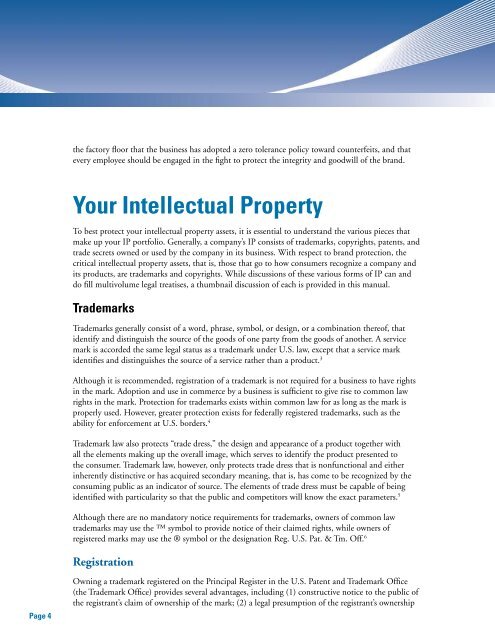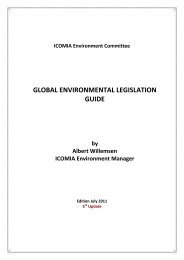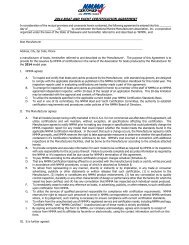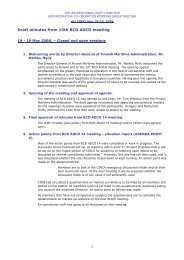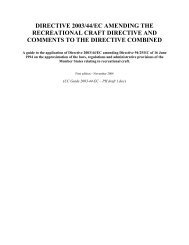Intellectual Property Protection and Enforcement Manual - Ipr-policy.eu
Intellectual Property Protection and Enforcement Manual - Ipr-policy.eu
Intellectual Property Protection and Enforcement Manual - Ipr-policy.eu
Create successful ePaper yourself
Turn your PDF publications into a flip-book with our unique Google optimized e-Paper software.
the factory floor that the business has adopted a zero tolerance <strong>policy</strong> toward counterfeits, <strong>and</strong> that<br />
every employee should be engaged in the fight to protect the integrity <strong>and</strong> goodwill of the br<strong>and</strong>.<br />
Your <strong>Intellectual</strong> <strong>Property</strong><br />
To best protect your intellectual property assets, it is essential to underst<strong>and</strong> the various pieces that<br />
make up your IP portfolio. Generally, a company’s IP consists of trademarks, copyrights, patents, <strong>and</strong><br />
trade secrets owned or used by the company in its business. With respect to br<strong>and</strong> protection, the<br />
critical intellectual property assets, that is, those that go to how consumers recognize a company <strong>and</strong><br />
its products, are trademarks <strong>and</strong> copyrights. While discussions of these various forms of IP can <strong>and</strong><br />
do fill multivolume legal treatises, a thumbnail discussion of each is provided in this manual.<br />
Trademarks<br />
Trademarks generally consist of a word, phrase, symbol, or design, or a combination thereof, that<br />
identify <strong>and</strong> distinguish the source of the goods of one party from the goods of another. A service<br />
mark is accorded the same legal status as a trademark under U.S. law, except that a service mark<br />
identifies <strong>and</strong> distinguishes the source of a service rather than a product. 3<br />
Although it is recommended, registration of a trademark is not required for a business to have rights<br />
in the mark. Adoption <strong>and</strong> use in commerce by a business is sufficient to give rise to common law<br />
rights in the mark. <strong>Protection</strong> for trademarks exists within common law for as long as the mark is<br />
properly used. However, greater protection exists for federally registered trademarks, such as the<br />
ability for enforcement at U.S. borders. 4<br />
Trademark law also protects “trade dress,” the design <strong>and</strong> appearance of a product together with<br />
all the elements making up the overall image, which serves to identify the product presented to<br />
the consumer. Trademark law, however, only protects trade dress that is nonfunctional <strong>and</strong> either<br />
inherently distinctive or has acquired secondary meaning, that is, has come to be recognized by the<br />
consuming public as an indicator of source. The elements of trade dress must be capable of being<br />
identified with particularity so that the public <strong>and</strong> competitors will know the exact parameters. 5<br />
Although there are no m<strong>and</strong>atory notice requirements for trademarks, owners of common law<br />
trademarks may use the symbol to provide notice of their claimed rights, while owners of<br />
registered marks may use the ® symbol or the designation Reg. U.S. Pat. & Tm. Off. 6<br />
Registration<br />
Page 4<br />
Owning a trademark registered on the Principal Register in the U.S. Patent <strong>and</strong> Trademark Office<br />
(the Trademark Office) provides several advantages, including (1) constructive notice to the public of<br />
the registrant’s claim of ownership of the mark; (2) a legal presumption of the registrant’s ownership


